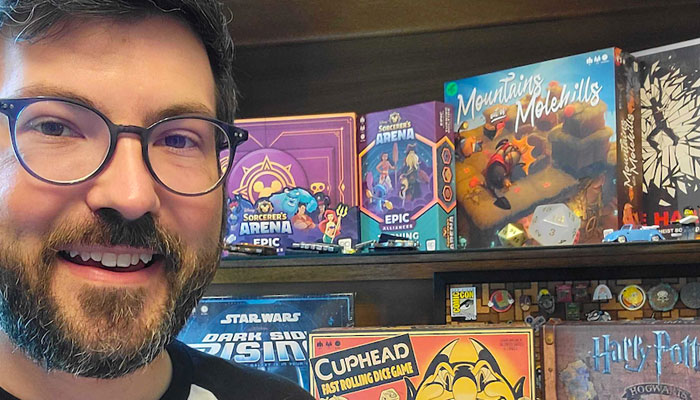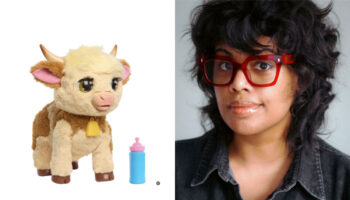Pat Marino – Director of Hobby Games at The Op – on making Mountains Out of Molehills

Pat, it’s great to catch up. For anyone that hasn’t seen Mountains Out of Molehills yet, how would you pitch the game?
In Mountains Out of Molehills, each player is a mole, digging underground on the lower level of a two-level gameboard. With each movement, the moles cause dirt to pile above them on the top board. This is tracked by stacking molehill pieces in the player colours on the upper spaces. The player whose dirt is on the base of a stack controls it, and it’s worth as many points as the stack is tall. But, there are a few catches!
First, moles don’t see very well, especially underground in the dark – so they must draft and plan four moves at a time using action cards and an action programming mechanic. Once the plans are set, players cannot change them.
Second, if a stack of dirt gets too tall it will topple over sending molehill pieces cascading across other stacks, and sometimes causing a ripple effect across the board! This creates for a strategic, and sometimes chaotic, area control game. With six rounds of scoring and stacks that increase in height throughout the game, it stays competitive right to the end.

Where did the seed of the idea come from? Was the two-level game board there from the get-go?
This game was designed by my brother Jim DiCamillo and I. I looked back at the original email where Jim pitched the idea and the game actually didn’t start with a two-level board. Jim came up with the overall concept based on the expression ‘Don’t make mountains out of molehills.’ Originally, the concept was stacked discs on a 6×6 grid and the moles were moving on top of their stacks. It had the topple effect, which was originally called ‘spillage.’
As we discussed the game more, it felt off thematically that the moles would be on top of the dirt and not below ground. I think we were hesitant to try a two-level board due to anticipated production challenges and costs, but once we made the leap the game really started to come together.
As well as looking great on the table, the two-level game board feels like it helps players get to grips with how the game plays… It connects well with the theme and makes it all quite intuitive.
We always try to blend theme, components and mechanics as much as possible. In this case, I feel like the theme really does make rules intuitive – and we’ve noticed that reviewers and people learning the game at demos tend to repeat some of the thematic hints from the rules.
For example, ‘moles don’t see well so they have to plan their actions’ or ‘moles are polite so they won’t push through another mole if someone is in their way.’ Elena Muñoz did a fantastic job of bringing the art to life and giving personality to the moles too, which I think really helped the immersion.

As for the two-layer board, it took quite a bit of engineering to get it right and have it be stable, but we’ve had a lot of players reference moles creating tracks through their lawn and some references to old Bugs Bunny cartoons where he tunnels underground and creates the dirt path above. I think these reference points – and the stacked board – help people get into the game quickly.

Yes, theme-wise, it’s a really smart match for the gameplay.
Jim and I both usually lean towards designing around mechanisms we find interesting, but in this case the theme came first and really shaped the development of the game play and the components. The original concept did not have action programming, but that system evolved to fit the poor eyesight of the moles.
As we design games and evaluate inventor submissions at The Op, it’s becoming more and more important to us to have that blend of theme and mechanics so that players create a story with their experience.
Before we let you go Pat, a few questions unrelated to Mountains Out of Molehills. Firstly, what would you say is your most underrated game design? We can give it the spotlight here!
That’s a great question. I think each of my games has found a niche of fans, but none have really blown up yet. Court of the Dead: Mourner’s Call is probably the one that was most underrated. A lot of people who have played and reviewed it really liked it, but due to the cost of the game it didn’t have much of a retail life after Kickstarter, so I think a lot of folks have never had a chance to try it.

Interesting. I’ll check it out! Last question: how do you fuel your creativity? What helps you have ideas?
I love board games and I tend to be a curious, exploratory gamer, so I’m always looking to try the latest new games and expand my collection. More importantly, Jim and I are very close and talk daily about game design ideas. We tend to think alike, but not the same, so we are able to riff off of each other well.
The biggest challenge we have is a lack of time to implement all of our ideas! In my day-to-day work at The Op, my focus has shifted more to planning and working with inventors, which is really inspiring. There are so many passionate inventors out there and they continue to push the envelope for creative game design.
I do get some time for game design still and a lot of my creativity at work comes from blending popular IPs with game systems to create an experience that serves the fans of that IP – though I do get some time for original game development as well.
Great stuff. Pat, a huge thanks for taking time out for this. Let’s tie-in again soon!
–
To stay in the loop with the latest news, interviews and features from the world of toy and game design, sign up to our weekly newsletter here






















